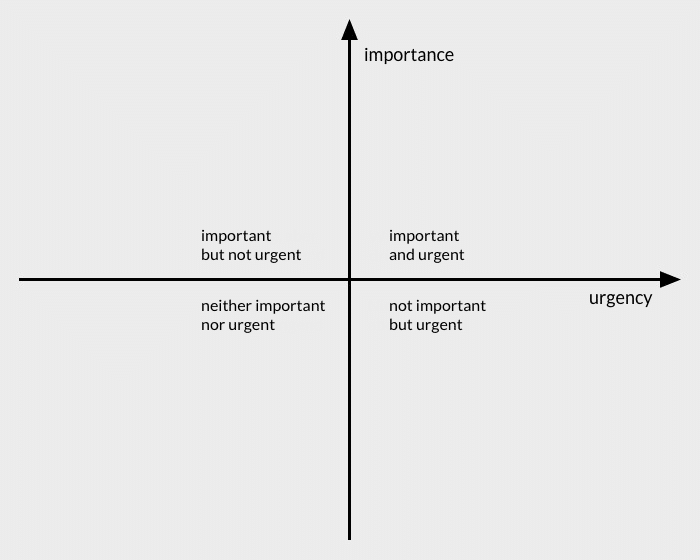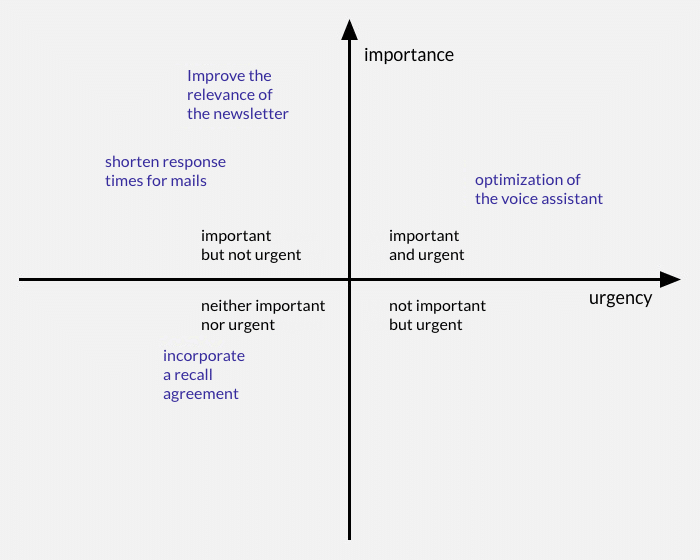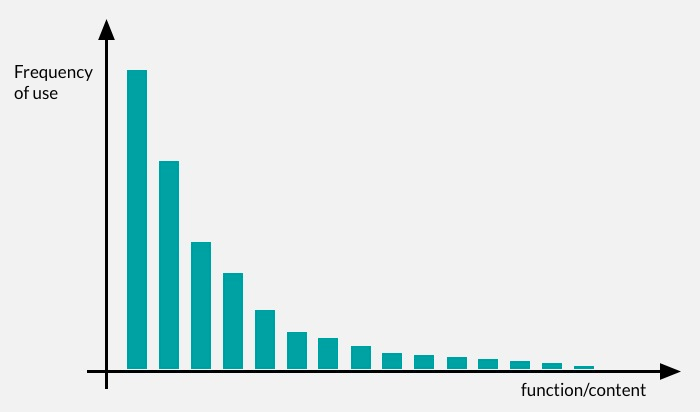Use existing key figures as a basis
Check if you already have metrics that you can use for the evaluation. A good starting point is, for example, the calculation of the return on investment. With this you know which measure brings how much profit.
But not for all measures the ROI can be calculated meaningfully. If you create a customer journey map, for example, you will have a lot of valuable information about your customers in front of you and can make much better decisions. But you cannot calculate a direct ROI for this.
It is always crucial that you first get to know the customers or users as well as possible and in the process determine their pain points and expectations. Only then do you move on. If you find that there are deficits here, you should first take care of them.
Methods for prioritization
The ROI determination is sometimes not possible, often not easy and generally always time-consuming. So if you have not already determined the ROI, I recommend the following procedure:
Determine internal criteria
For a first classification or evaluation of the found problems or weaknesses you ask:
1. How serious is the problem found?
A common categorization for this question is
- Showstopper: Customers cancel their contract, or interested parties do not become customers because of this problem.
- Serious: The experience is negative, usage is difficult, the impression is bad, complaints come in.
- Difficult: The customer is annoyed.
- Medium: The customer has more trouble than necessary.
- Easy: Aesthetic details; small things that only a few people notice
Instead of these terms you can also use numbers from 1 to 5 – but they have the disadvantage that you do not know immediately whether 1 stands for the critical problems or for the easy ones.

Some also use only 4 or only 3 categories – that is a matter of taste. In any case, it is important that you classify the identified problems with this method from the customers’ point of view. At the same time this is also an evaluation from a business point of view. Because if the customers are not satisfied, the business suffers.
In most cases, the most problematic issues for the customers are also those that are most critical for your business.
2. How much effort does the problem-solving cause?
Sometimes an effort criterion is added to the above-mentioned criteria. That means, for each problem found, you indicate how much effort will be needed to solve the problem. Approximately:
- High
- Medium
- Low
You should define the three criteria according to how your team works:
- “High” can mean, for example, that the effort to fix the problem takes longer than a sprint (time-defined implementation cycle of 1, 2 or 4 weeks).
- Or you can define how many man-days are required to solve the problem. For example, “High” could mean that 3 man-days are needed to solve the problem.
This method with its two categories of severity and effort is quick and easy to implement, and you should definitely implement this method if you are not prioritizing at all at the moment. If you want to be a little more precise, there are other ways to refine it.
Classic No. 1: Eisenhower Matrix
When it comes to prioritizing CX measures, you are ultimately concerned with decision making. And this is a well-known problem. The US President Dwight Eisenhower (President in the 1950s) is credited with the matrix named after him.
It consists of 4 quadrants, which are formed by the 2 axes of urgency and importance.

- Sort out unimportant problems: You would think the method is trivial, yet it is a tool that helps you to name the things you don’t need to worry about at all.
Because when we have a list of problems or ideas for improvement in front of us, we tend to just want to work through them all.
With the help of the Eisenhower Matrix , you realize that this is not necessary. It’s that you can simply ignore individual things.
- Facilitates teamwork: The matrix is particularly helpful in a team: When you work together in a meeting to make the assignments, you will quickly notice if not everyone has the same view of urgency and importance. In this way, you can quickly and in a structured way enter into a goal-oriented discussion.
Classic No. 2: Decision Matrix
The decision matrix goes one step further than the Eisenhower matrix. Here you evaluate or prioritize elements based on several quantitative and qualitative criteria.
This can be very simple or quite complex. An example is the best way to see how it works. We use the different methods in practice:
Let’s assume that you found out in your last customer survey that the following points apply to more than 30% of your customers:
- The customers find the response times to mails to customer service too long.
- They don’t like the voice wizard that greets them in the call center before they are put through to an agent.
- They find the contents of the customer newsletter uninteresting.
- They would like a function on the website where they can arrange a callback.
A simple evaluation would then look like this, for example:
| Topic | Difficulty | Effort for optimization |
| Reduce response time mails | medium | high |
| Optimization language assistant | serious | high |
| Improve newsletter relevance | medium | medium |
| Install callback agreement | easy | low |
However, the Eisenhower matrix produces a different picture:

This also reveals the weakness of the Eisenhower matrix: The placement of the elements happens to a certain extent also from the gut feeling.
The decision matrix provides values that are somewhat easier to understand. And, very important: You can also have all team members fill out the decision matrix and then calculate an average value. That way, you can reach acceptable compromises without having to spend hours discussing.
In our example, the decision matrix would look like this, filled in by yourself:
| Topic | Influence on satisfaction | Influence on payment/cancellation | Effect on frequency of use | Total value Ø |
| Reduce response time mails | 3 | 1 | 1 | 1,7 |
| Optimization language assistant | 5 | 2 | 2 | 3 |
| Improve relevance of newsletter | 3 | 1 | 4 | 2,7 |
| Install recall agreement | 2 | 2 | 1 | 1,7 |
This is the simplest form.
The next step is to ask your colleagues as well. Then you would be at such a picture (here a total of 3 colleagues have voted):
| Topic | Influence on satisfaction | Influence on payment/cancellation | Effect on frequency of use | Total value Ø |
| Reduce response time mails | 3/2/4 (Ø 3) | 1/1/2 (Ø 1,3) | 1/1/3 (Ø 1,7) | 2 |
| Optimization language assistant | 5/5/5/ (Ø 5) | 2/1/2 (Ø 1,7) | 2/2/2 (Ø 2) | 2,9 |
| Improve relevance of newsletter | 3/4/4 (Ø 3,7) | 1/1/1 (Ø 1) | 4/2/4 (Ø 3,3) | 2,7 |
| Install recall agreement | 2/5/2 (Ø 3) | 2/2/3 (Ø 2,3) | 1/1/1 (Ø 1) | 2,1 |
Alternatively, you can have each department give a rating, e.g. Product Development, Finance, Marketing, Sales, IT, etc.
The next step is to add weighting factors. This means that you give each criterion a weighting, how strongly it should be included in the decision.
Criterion 1: Influence on satisfaction
(with evaluation of 3 persons: A, B, C)
| Topic | A | B | C | Σ | Weighting | Σ weighted |
| Reduce response time mails | 3 | 2 | 4 | 3,0 | 2 | 6,0 |
| Optimization language assistant | 5 | 5 | 5 | 5,0 | 2 | 10,0 |
| Improve relevance of newsletter | 3 | 4 | 4 | 3,7 | 2 | 7,3 |
| Install recall agreement | 2 | 5 | 2 | 3,0 | 2 | 6,0 |
Criterion 2: Influence on payment/cancellation
(with evaluation of 3 persons: A, B, C)
| Topic | A | B | C | Σ | Weighting | Σ weighted |
| Reduce response time mails | 1 | 1 | 2 | 1,3 | 3 | 3,9 |
| Optimization language assistant | 2 | 1 | 2 | 1,7 | 3 | 5,1 |
| Improve relevance of newsletter | 1 | 1 | 1 | 1,0 | 3 | 3,0 |
| Install recall agreement | 2 | 2 | 3 | 2,3 | 3 | 6,9 |
Criterion 3: Influence on frequency of use
(with evaluation of 3 persons: A, B, C)
| Topic | A | B | C | Σ | Weighting | Σ weighted |
| Reduce response time mails | 1 | 1 | 3 | 1,7 | 1 | 1,7 |
| Optimization language assistant | 2 | 2 | 2 | 2,0 | 1 | 2,0 |
| Improve relevance of newsletter | 4 | 2 | 4 | 3,3 | 1 | 3,3 |
| Install recall agreement | 1 | 1 | 1 | 1,0 | 1 | 1,0 |
Merge the weighted sums of all three criteria (K1-K3):
| Topic | K1 | K2 | K3 | Total value |
| Reduce response time mails | 6,0 | 3,9 | 1,7 | 1,7 |
| Optimization language assistant | 10,0 | 5,1 | 2,0 | 2,0 |
| Improve relevance of newsletter | 7,3 | 3,0 | 3,3 | 3,3 |
| Install recall agreement | 6,0 | 6,9 | 1,0 | 1,0 |
And finally, you can also take into account the effort required for the implementation. In this case, you take small numbers for a lot of effort – because the things that are a lot of work should get a lower priority than those that take a lot of effort to implement.
The nice thing about the decision matrix is that it gives you a clearly ordered list that you can use as a guide.
The disadvantage is that sometimes you may not like the result. This is usually because the weighting factors are not correct. But changing them afterwards can make the method absurd: You run the risk of manipulating them in such a way that in the end you get what you wanted from the beginning. Therefore, you should better resist this temptation.
Just in passing, we should mention a special form of decision matrix: the utility value analysis (NWA). This is well known in the business world, and even more complex, so it is rarely used in the CX area.
ICE Score
In contrast, the ICE score is widely used. The abbreviation ICE stands for Impact, Confidence and Effort. You now give each of these points a value:
- Impact: Here you evaluate the influence that the measure has on the CX
- Confidence: Here you evaluate with what certainty you can say whether the idea will actually improve the CX
- Effort: Here you evaluate the effort you have to put into implementing the idea
For each of these points you give a value from 1 to 10 and then form the sum of all three. So every possible action has a value between 3 and 30. All you have to do now is to sort this list in descending order – this way you know in which order you proceed best.
In our example it looks like this:
| Topic | Impact | Confidence | Effort | Σ |
| Reduce response time mails | 4 | 6 | 8 | 18 |
| Optimization language assistant | 6 | 7 | 9 | 22 |
| Improve relevance of newsletter | 5 | 8 | 6 | 19 |
| Install recall agreement | 2 | 7 | 2 | 11 |
The ICE score is the basis for several other scores:
RICE Framework & Co.
RICE stands for:
- Reach
- Impact
- Confidence
- Effort
In addition to the 3 criteria of the ICE-Score the criterion Reach is added. Reach is used to assess how many customers or users are estimated to benefit from the optimization.
The whole thing is further supplemented and specified in various other frameworks. One example is the framework by Gabrielle Bufrem, representing many others. It has the following criteria:
- Reach
- Customer Impact
- Business Impact
- opportunity cost
- Confidence
- Effort
It therefore fits very well for the CX range.
Most of the points you know or they are self-explanatory. New here is only Opportunity Cost. This is, so to speak, the money or the time you lose if you don’t take care of this problem. For example, because the support effort is unnecessarily high or customers cancel.
By the way, you don’t necessarily have to work with numbers and assign a point value to each criterion. Some people also use ICE & Co simply as a thinking aid and put text in the respective table fields. This can be a good start for systematic prioritization.
Now we come to two completely different methods, which do not come from the business administration or product manager environment like the above, but from conception and user research.
Top-Task-Analysis
Providers of software, digital services and other products in particular face the challenge of never knowing exactly which functions users really need.
Firstly, resources (time, money) are limited, and therefore not everything can be implemented. Secondly, too many functions lead to overloaded products that are difficult to overview and use.
That’s why the Irish concept developer Gerry McGovern developed the Top-Task-Analysis many years ago. The approach is surprising. It works as follows:
- You present your customers/users with a long list of possible functions or tasks to be done (“tasks”), often the list contains 50-80 points.
- Your customers should choose the 5 tasks that are most important to them. Sometimes they are only given 3 minutes to do so.

Normally, users complain and say that it is impossible to keep track of this. But that’s part of the recipe for success.
Processing such a long list is stress. And when time pressure is added, it is enormous stress. It forces the human brain to concentrate on the most important things – and that’s why we have the participants in the analysis exactly where we want them.
From about 30 respondents on, the most important tasks crystallize out. Most of the time, with 75 tasks, there are around 15, which are named by most participants.
This method has proven itself to be effective in optimizing countless websites, intranets, applications and programs. With it you can find out what is really important to your customers/users with relatively little effort.
Of course you need some real customers or users for this, because you can’t use this method with colleagues or in a team.
Dot Voting
Finally, a good and effective method of how you can reach an agreement in a meeting or workshop: with dot voting.
Dot Voting means “dot gluing”. With this method, all participants stick dots on the proposals you have written on a whiteboard or flipchart as a sketch or even as a term. The proposal with the most dots wins.

The methodology looks like this:
- Whenever you cannot agree, you can use this methodology in a meeting. This can be planned, or it can be done spontaneously, because you normally only need 15 to a maximum of 30 minutes.
- If the ideas are easy to visualize, draw a scribble or symbol for each idea on a moderation card or an A5 sheet (A4 folded/half). Or simply write a keyword on a post-it.
- Then you present each idea again in a few sentences or you summarize the most important part of the idea.
- Now each participant gets sticky dots – the number depends on how many ideas you have for voting. There should not be more than half as many dots per person as you have suggestions. So if there are 6 possibilities, then you give out a maximum of 3 points per person.
- Now you set a timer and in the next 3 minutes all your points have to stick to the suggestions that you think are the best. You can stick all points on one idea or you can distribute the points nicely. And of course you may vote for your own idea.
- You should not speak during the voting. This method is used to make a decision. If there is still need for discussion, you should not vote yet.
- In the end, you sort the results by score – the ones with the most points go up and are therefore the ones with the highest priority.
A variant of this method is the secret ballot. Everyone writes down on a piece of paper which ideas get their points. You then collect them and stick the points yourself.
You do this, for example, if you have strongly hierarchical groups. So if the employees orientate themselves towards their superiors and wait to see where they stick their points – and then place their own points there as well.
When which method?
You see, there are a number of techniques to get away from pure gut decisions. But when do you use which?
Here is a small overview to help you choose the one that suits you best:
| Method | Time | Complexity | Benefits | Especially suitable for |
| Difficulty/expense | ° | ° | + | quick assessment |
| Eisenhower Matrix | ° | ° | + | Sort out the unimportant topics |
| Decision Matrix | + | ° | ++ | thorough assessment; also possible remotely |
| Utility Value Analysis | ++ | + | ++ | Number-driven teams |
| ICE-Score | ° | + | + | easy prioritization |
| RICE-Framework | + | + | ++ | advanced prioritization |
| Top-Task-Analysis | ++ | ++ | ++ | Prioritization Features/Functions |
| Dot Voting | ° | ° | + | Decision making in a team |
It is always a good idea to approach prioritization in a good and structured way. But adjust the effort to the complexity of the problems – you shouldn’t need a week for prioritization for things that can be done in a few person days.
Conclusion: Prioritize and implement quickly
Decisions based purely on gut feeling do not make optimal use of resources. Normally, it is the case that not all ideas for improvement are implemented anyway. This is because there is not enough time or manpower to start a new project or the focus shifts.
Or some problems are no longer current because the product, the website or the organizational structure has changed in the meantime.
Therefore, it makes sense to fix the most urgent problems right away and also those that are easy to fix. This way you can make the best use of your resources and ensure that your work always has the maximum effect.
More about Customer Satisfaction
- 8 methods for analyzing customer satisfaction
- Everything you need to know about customer satisfaction
- 8 (atypical) measures to improve customer satisfaction
- Proving customer satisfaction with key performance indicators
- 8 reasons why increasing customer satisfaction doesn’t work!
- How you can measure the level of customer satisfaction
- Customer Satisfaction and Customer Loyalty: correlation and differences
- Example structure of a customer satisfaction survey: structure for valuable insights
- Customer Satisfaction and Customer Retention: success factors for sustainable growth




